The Samsung Galaxy S6 and S6 edge Review
by Joshua Ho on April 17, 2015 9:00 AM EST- Posted in
- Smartphones
- Samsung
- Mobile
- Galaxy S6
- Galaxy S6 Edge
System Performance
In order to test the Exynos 7420 and the phone in general, we turn to our suite of benchmarks which are able to show how the device performs in common general computing workloads. Something as simple as web browsing is still surprisingly intensive on mobile phones, and in general Android can often be quite stressful to run in the constraints of a ~3W total TDP especially on any phone still running Dalvik due to its strong reliance on bytecode and a virtual machine that translates bytecode to machine code just before and during application runtime. ART improves this significantly, but is limited in the nature of optimization as AOT compilation optimizations are limited by the CPU power of the SoC and the need to compile the application in a reasonable amount of time.
As always, we'll start things off with our browser benchmarks. After getting to use the phone, it became clear to me that Chrome is poorly optimized against the Galaxy S6 as Samsung’s browser is clearly superior in performance. For that reason I've gone ahead and run our benchmarks on both Chrome and on the stock browser, as seen below.
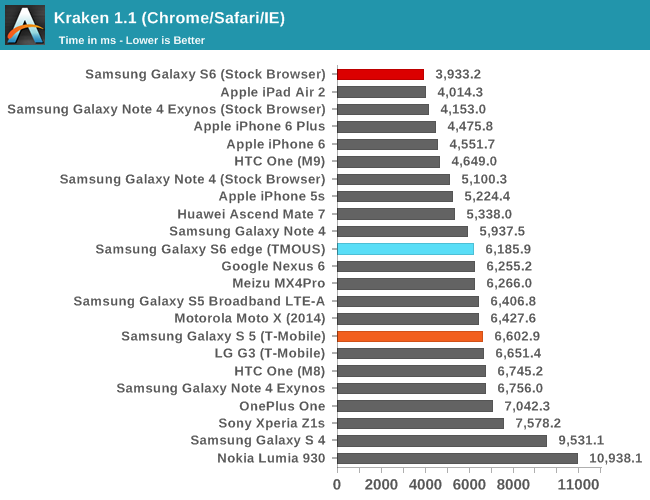
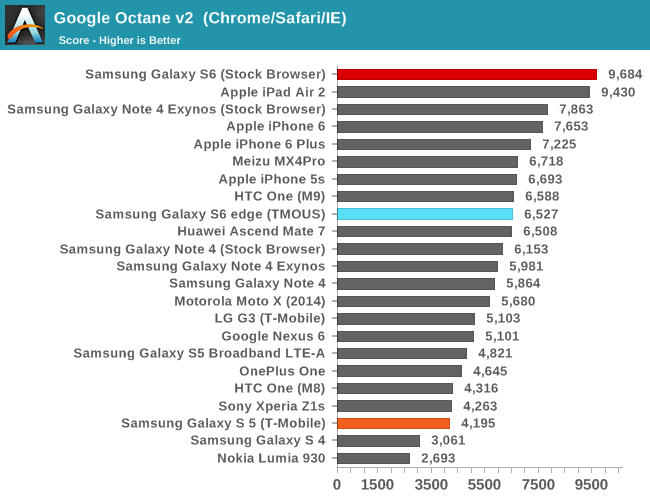
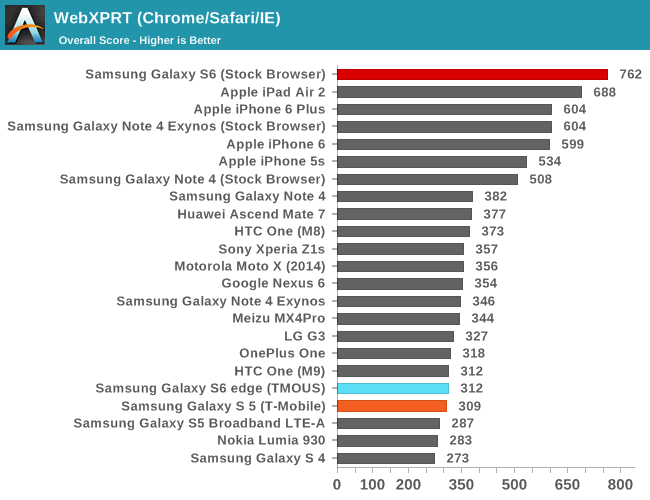
Needless to say, in order to see the full potential of the Exynos 7420 and its cluster of A57s, it’s necessary to use Samsung’s stock browser. This performance is really quite amazing when compared to Apple’s A8X, which has basically been the gold standard for performance in the mobile space in the context of ARM SoCs.
Moving on, as a part of our updates to the benchmark suite for 2015, we'll take a look at Basemark OS II 2.0, which should give a better picture of CPU performance in addition to overall device performance.
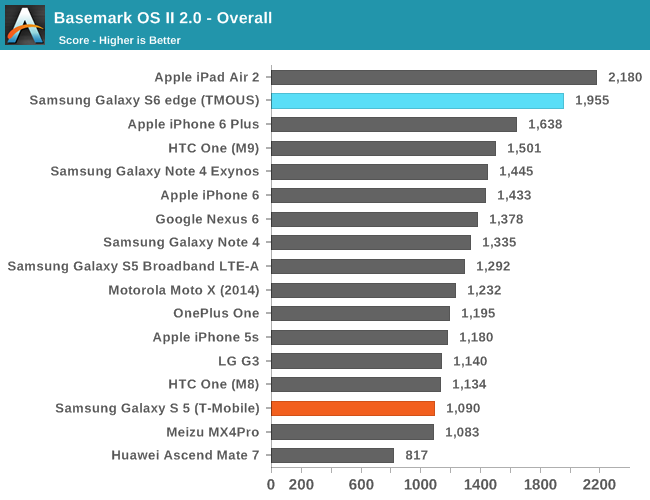
The browser benchmarks seem to hide some pretty enormous variability as the Galaxy S 6 edge (which is comparable to the Galaxy S 6) sets a new record among Android devices. The only challenger is the iPad Air 2, which uses the A8X SoC with three Enhanced Cyclone cores and the semi-custom GXA6850 GPU.
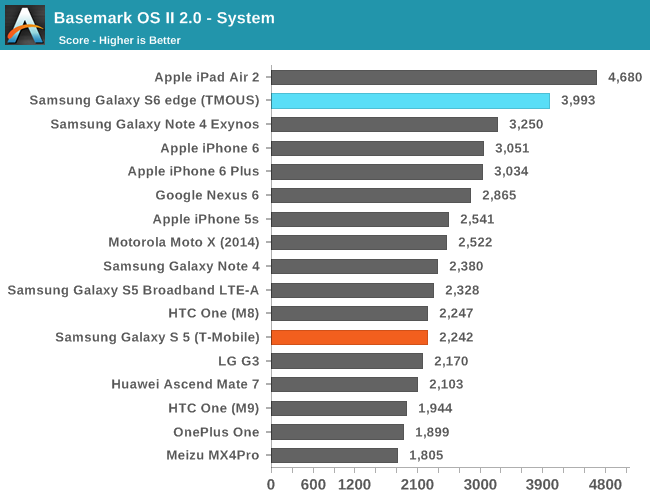
This system test contains a floating point and integer test, in addition XML parsing, which means that this test mostly stresses CPU and RAM. Interestingly enough, the Exynos 7420 pulls far ahead of both the Exynos 5433 and Snapdragon 810 in this test, and approaches the A8X. The difference between the 5433 and 7420 is likely a combination of the higher clocks on both the A57 and A53 clusters for the 7420 (1.9/1.3 on the 5433, 2.1/1.5 on the 7420), in addition to the ability to stay at a high 'overdrive' clock due to reduced leakage from the 14LPE process. The One M9 likely falls a bit short here due to HTC's governor settings restricting the use of all 8 cores simultaneously.
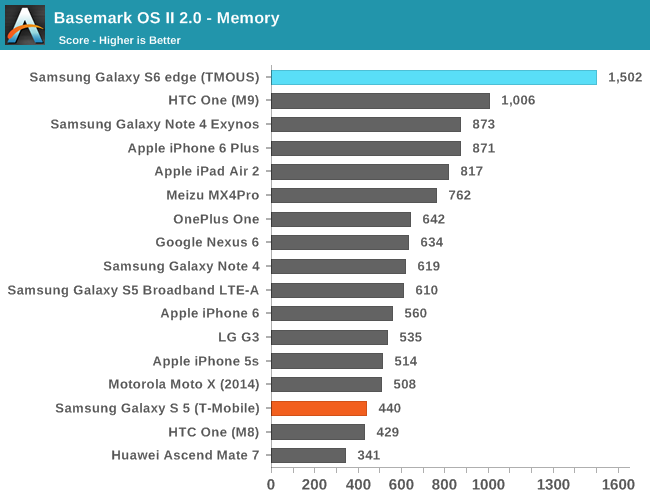
While one might guess that the memory test of 'Basemark OS II 2.0 - Memory' is of RAM, this is actually a test of the internal storage. Once again we see the S6 edge come close to leading the pack due to the use of the new UFS (Universal Flash Storage) standard. Casual examination reveals that the S6 edge has a queue depth of 16, and that it identifies itself with the rather cryptic model name of KLUBG4G1BD-E0B1.
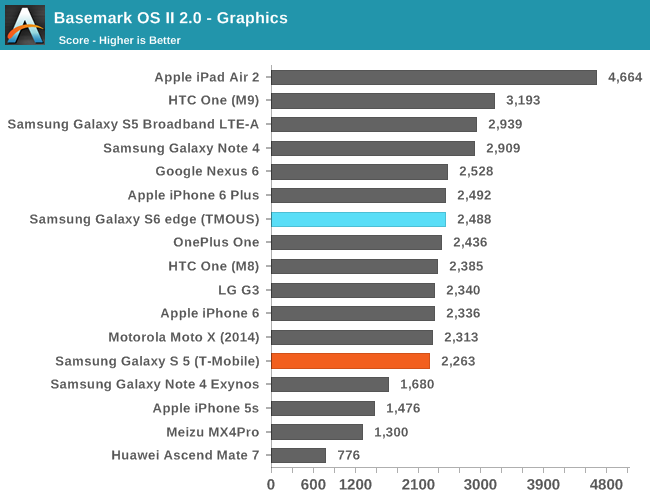
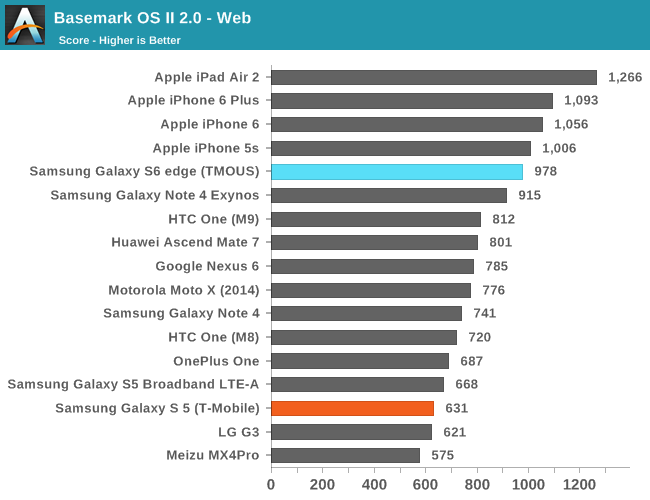
For the web test, it uses the built-in WebView rendering engine rather than Chrome and paints a distinctly different picture, especially because these tests are focused on HTML5 and CSS rather than JavaScript. Here we can see that the iPhone 6 and iPad Air 2 continue to hold their lead, but the Galaxy S6 is pretty much the king of the hill when it comes to Android devices.
Our next system benchmark is PCMark, which does a number of basic benchmarks designed to stress various aspects of the device in everyday workloads like video playback, web browsing, text editing, and photo editing. This tends to test every aspect of a mobile device, unlike microbenchmarks that can often miss aspects of the system that can affect performance.
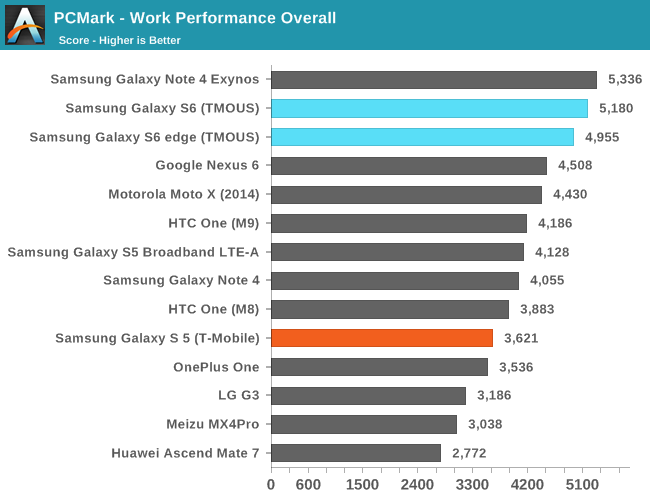
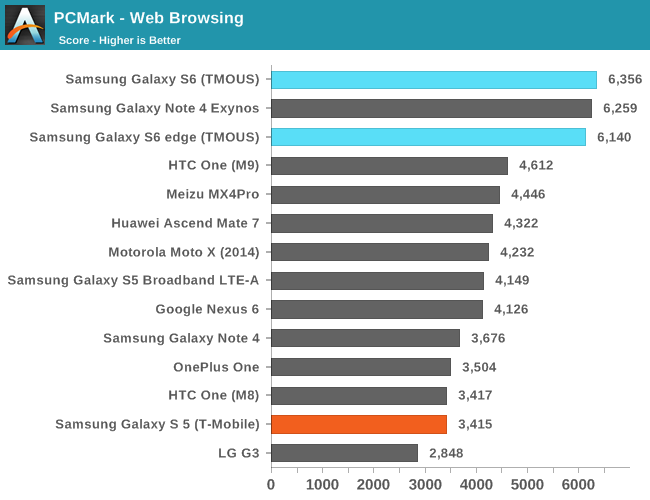
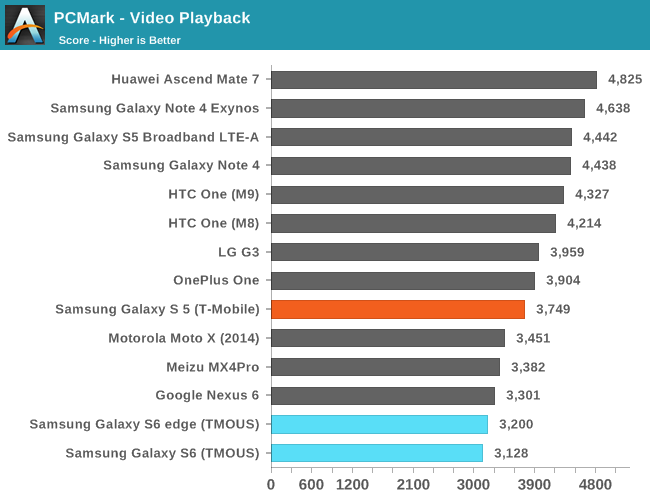
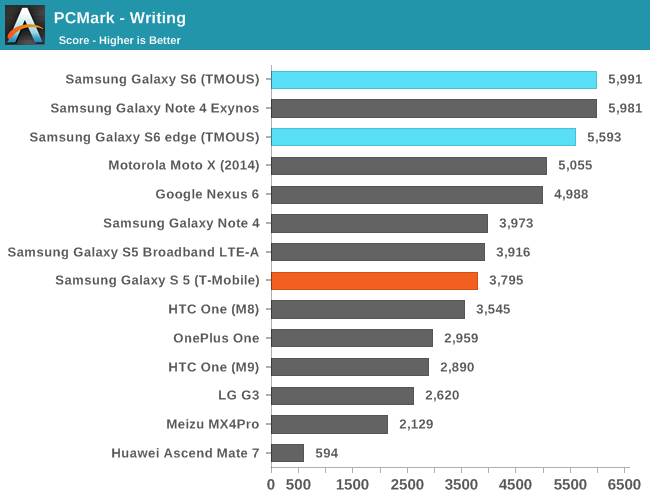
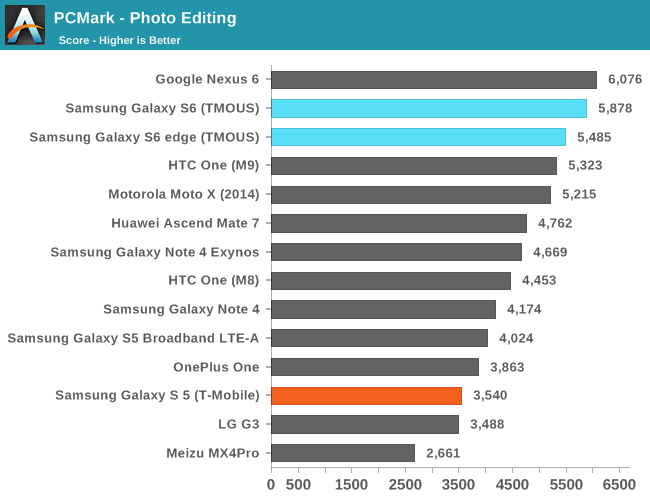
In these tests, the Galaxy S6 continues to perform strongly here due to the fast NAND storage solution and the Exynos 7420 SoC. As we have already covered the Basemark OS II 2.0 results in previous articles, I would refer back to it as those scores are final and have already been contextualized.
Overall, in these general purpose computing tasks that stress CPU, memory, and NAND performance we can see that the Exynos 7420 is off to a flying start. Samsung Mobile should focus more strongly on optimizing the software stack against Chrome as mobile Chrome has around twice the user share of stock Android browsers. I often say that the SoC is the foundation to a good smartphone, and in the case of the Galaxy S6 it feels like this is especially true.










306 Comments
View All Comments
juxt417 - Wednesday, April 22, 2015 - link
Unlike apple. Samsung has a solid reason to not have an SD card. This being that an SD card is too slow to handle 4k content without a lot of lag.Ufs 2.0 on the other hand handles 4k just fine. At least from what I have experienced so far.
Matthew Sobel - Monday, April 20, 2015 - link
They make so many smart phones because there are so many markets & carriers and they all want to be special.I'm with you on the wish for two branches of the Samsung family tree. Don't forget about the 'Active' variant. There's speculation that this is still coming. If so it may be just what some of us are looking for.
FlushedBubblyJock - Friday, April 24, 2015 - link
The reason you won't get the choice is the constantly complaining crybaby crew has for years whined for an apple rectangle metal box with a brokenback glass rainbow they can selfie with in the mirror and prance around with feeling it up for a "quality industrial design build".Then they need it thinner like their figures should be, thinner because a metal clodheaded rectangle with heavy glass is a lead weight, thus paper thin is necessary, as it "gains status for eyebrow lickers".
See, we call this "the market". The primping faerie overlords knows what's best for their selfish little egos, and thus, you will be made into a dumbed down sheep in compliance with their frivolous vanities.
RiotSloth - Thursday, May 14, 2015 - link
That is the best thing I'm going to read all day. Thank you!Daniel S. Buus - Friday, July 17, 2015 - link
LOL :'D So much hate :Dh3ck - Friday, May 8, 2015 - link
I agree, the Note 5 will be for the power user and/or business person that wants to "have it all". Where as the Galaxy S line will be consumer friendly and geared toward "ease of use".medi03 - Sunday, April 19, 2015 - link
That will surely "help" increase sales, right.FlushedBubblyJock - Friday, April 24, 2015 - link
medi03 - see the finely tuned mind bending the sales crew sells to the clueless primpers>"Overall, the design of the Galaxy S6 and S6 edge is really unlike anything else they’ve produced in recent memory. The phone itself is well-sized and feels much more ergonomic than the Galaxy S5 due to the thinner build and mildly reduced bezel size. It really feels like Samsung cared about the design of the phone this generation, and the attention to detail here immediately puts Samsung near the top in this area. "
Ahh, they "cared" - it feels - even the word ergonomic, when the truth is it's a slippery heavy metal and smoothie glass nightmare ready to crash to the ground... at least the braindead can't "flex it" - the best feature of course is - it's apple clone "quality" for the elite snobs
Yeah man, that's it bro.
edlee - Monday, June 29, 2015 - link
how did anandtech find out what pvs bin they received, did they check it with a terminal command, and if so, what was that command?Flunk - Friday, April 17, 2015 - link
I predict that Samsung won't lose any customers because of this. Where are you going to find a modern phone with a removable battery and SD card slot? There just isn't any option anymore. Samsung is trading a few niche features for more mainstream appeal.P.S. Samsung will replace the battery for $45, but I imagine that a lot of people reading this site can just swap it themselves.